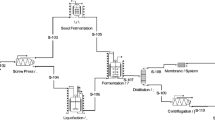Abstract
Technoeconomic analysis has been used to guide the research and development of lignocellulosic biofuels production processes for over two decades. Such analysis has served to identify the key technical barriers for these conversion processes so that research can be targeted most effectively on the pertinent challenges. The tools and methodology used to develop conceptual conversion processes and analyze their economics are presented here. In addition, the current process design and economic results are described for dilute acid pretreatment followed by enzymatic hydrolysis and fermentation. Modeled ethanol costs of $1.33/gallon (in consistent year 2007 dollars) are being targeted for this commercial scale corn stover conversion process in 2012. State of technology models, which take actual research results and project them to commercial scale, estimate an ethanol cost of $2.43/gallon at present. In order to further reduce costs, process improvements must be made in several areas, including pretreatment, enzymatic hydrolysis, and fermentation. As the biomass industry develops, new fuels and new feedstocks are being researched. Technoeconomic analysis will play a key role in process development and targeting of technical and economic barriers for these new fuels and feedstocks.




Similar content being viewed by others
Notes
For example, a Memorandum of Understanding (MOU) between ConocoPhillips (COP), Iowa State, and NREL was recently announced. http://www.nrel.gov/news/press/2008/577.html.
Harris Group Inc Seattle, WA, http://www.harrisgroup.com.
References
Aden A (2008) Biochemical production of ethanol from corn stover: 2007 state of technology model. NREL/TP-510-43205, May 2008. http://www.nrel.gov/docs/fy08osti/43205.pdf
Aden A, Ruth M, Ibsen KN, Jechura J, Neeves K, Sheehan J, Wallace R (2002) Lignocellulosic biomass to ethanol process design and economics utilizing co-current dilute acid prehydrolysis and enzymatic hydrolysis for corn stover. NREL report TP-510-32438, June 2002. http://www.nrel.gov/docs/fy02osti/32438.pdf
Badger Engineers, Inc. Cambridge, MA (1987) Economic feasibility of an acid-hydrolysis-based ethanol plant. Subcontract Report SERI-STR-231-3142, Prepared under subcontract No ZX-3-03096-2, April 1987
Biomass Multi-year Program Plan (MYPP) (2008) Office of the biomass program, energy efficiency and renewable energy. US Department of Energy, March 2008. http://www1.eere.energy.gov/biomass/pdfs/biomass_program_mypp.pdf
Bull SR (1987) Comparative energetics and economics of alternative pathways for fuel production. Solar Energy Research Institute (SERI), Energy from Biomass and Wastes X, Institute of Gas Technology (IGT), pp 1183–1192, January 1987
Chem Systems Inc Tarrytown, NY (1987) Economic feasibility study of an enzymatic hydrolysis-based ethanol plant with prehydrolysis pretreatment. Subcontract Report Report SERI-STR-231-3135, Prepared under subcontract No XX-3-03097-1, April 1987
Dale BE (ed) (2005) Coordinated development of leading biomass pretreatment technologies. Bioresou Technol 96(18):1959–2032 (December 2005). http://www.sciencedirect.com/science/journal/09608524
EERE OBP Brochure (2008) Modeling tomorrow’s biorefinery: the NREL biochemical pilot plant, March 2008. http://www.nrel.gov/docs/fy08osti/41334.pdf
Galbe M, Zacchi G (1992) Simulation of ethanol production processes based on enzymatic hydrolysis of lignocellulosic materials using ASPEN PLUS. Appl Biochem Biotechnol 34–35:93–104. doi:10.1007/BF02920536
Himmel M, Vinzant T, Bower S, Jechura J (2005) BSCL use plan: solving biomass recalcitrance. NREL/TP-510-37902, August 2005. http://www.nrel.gov/docs/fy05osti/37902.pdf
Ibsen K (2006) Match the effort to the R&D investment. Chemical Engineering Progress (CEP), January 2006. American Institute of Chemical Engineers (AIChE)
Ibsen KN, Wooley RJ, Aden A, Ruth M (2000) Using databases to streamline process design and analysis. AIChE Spring 2000 National Conference, 3/09/00
Kwiatkowski JR, Mcaloon AJ, Taylor F, Johnston D (2006) Modeling the process and costs of the production of fuel ethanol by the corn dry-grind process. Ind Crops Prod 23(3):288–296
Landucci R, Goodman BJ, Wyman C (1994) Methodology for evaluating the economics of biologically producing chemicals and materials from alternative feedstocks. Appl Biochem Biotechnol 45/46:677–696. doi:10.1007/BF02941840
NREL Final Subcontract Report (1994) Biomass to ethanol process evaluation. Chem Systems, Tarrytown, NY, Appendix V, December 1994
Peters MS, Timmerhaus KD (1991) Plant design and economics for chemical engineers, 4th edn. McGraw-Hill, Inc., New York
Process Evaluator ICARUS (1997) Version 4.0 ICARUS Corporation, Rockville, MD (June):30. Now part of Aspen Technologies
Ruth MF, Thomas S (2003) The effect of corn stover composition on ethanol process economics. Presentation to the 25th Annual Symposium on Biotechnology for Fuels and Chemicals, May 4, 2003. http://www1.eere.energy.gov/biomass/pdfs/34040.pdf
Schell DJ, Riley C (1991) Technical and economic analysis of an enzymatic hydrolysis based ethanol plant. Solar Energy Research Institute (SERI), Technical Report, June 1991
Short W, Packey DJ, Holt T (1995) A manual for the economic evaluation of energy efficiency and renewable energy technologies. NREL/TP-462-5173, March 1995
Stock Exchange Announcement (2005) Novozymes and NREL reduce enzyme cost. April 14, 2005. www.novozymes.com
Stone & Webster Engineering Corp Boston, MA (1987) Economic feasibility of an enzyme-based ethanol plant. Subcontract Report SERI-STR-231-3138, Prepared under subcontract No ZX-3-03097-1, April 1987
Van Walsum P, Jayawardhana K (2004) Modeling of carbonic acid pretreatment process using aspen-plus. Appl Biochem Biotechnol 115:1087–1102. doi:10.1385/ABAB:115:1-3:1087
Wooley RJ, Ibsen KN (1999) Updated database for biofuels components. December 1999, NREL Internal report (Database Doc#4141)
Wooley RJ, Putsche V (1996) Development of an ASPEN PLUS physical property database for biofuels components. NREL, Golden, CO, Report MP-425-20685, April 1996
Wooley R, Ruth M, Glassner D, Sheehan J (1999a) Process design and costing of bioethanol technology: a tool for determining the status and direction of research and development. Biotechnology Process 15(5):794–803
Wooley R, Ruth M, Sheehan J, Ibsen KN, Majdeski H (1999b) Lignocellulosic biomass to ethanol process design and economics utilizing co-current dilute acid prehydrolysis and enzymatic hydrolysis current and futuristic scenarios. NREL report TP-580-26157, July 1999. http://www.nrel.gov/docs/fy99osti/26157.pdf
Wright JD (1998) Economics of enzymatic hydrolysis processes. Solar Energy Research Institute (SERI), Presented at the American Institute of Chemical Engineers Spring National Meeting, 6–10 March 1988, New Orleans, LA
Acknowledgments
This work was supported by the U.S. Department of Energy Office of the Biomass Program under contract No. DE-AC36-99GO10337 with the National Renewable Energy Laboratory (NREL).
Author information
Authors and Affiliations
Corresponding author
Rights and permissions
About this article
Cite this article
Aden, A., Foust, T. Technoeconomic analysis of the dilute sulfuric acid and enzymatic hydrolysis process for the conversion of corn stover to ethanol. Cellulose 16, 535–545 (2009). https://doi.org/10.1007/s10570-009-9327-8
Received:
Accepted:
Published:
Issue Date:
DOI: https://doi.org/10.1007/s10570-009-9327-8




